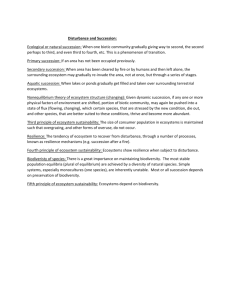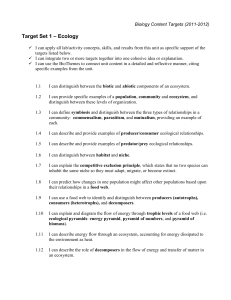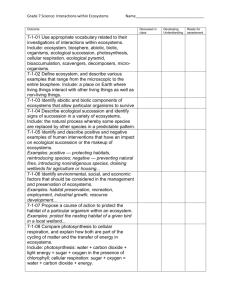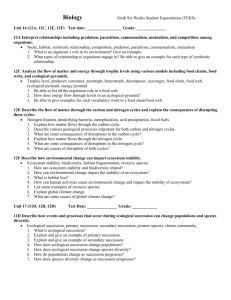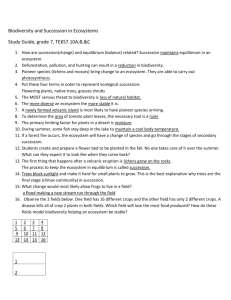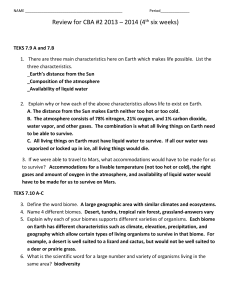AQUATIC ECOSYSTEMS
advertisement
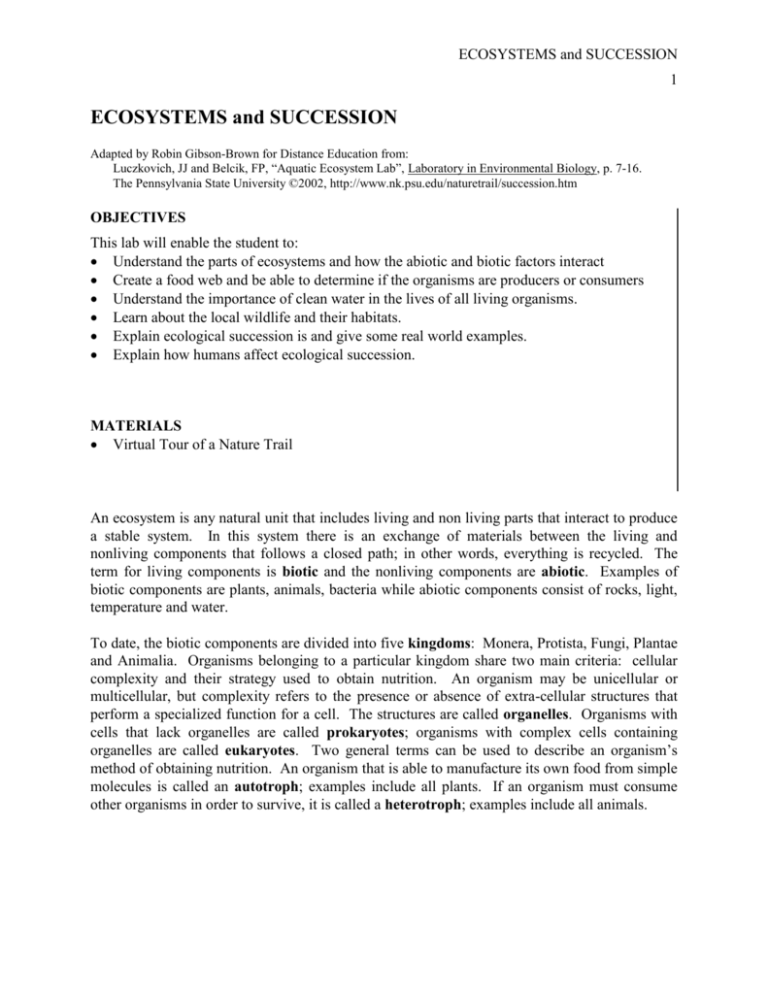
ECOSYSTEMS and SUCCESSION 1 ECOSYSTEMS and SUCCESSION Adapted by Robin Gibson-Brown for Distance Education from: Luczkovich, JJ and Belcik, FP, “Aquatic Ecosystem Lab”, Laboratory in Environmental Biology, p. 7-16. The Pennsylvania State University ©2002, http://www.nk.psu.edu/naturetrail/succession.htm OBJECTIVES This lab will enable the student to: Understand the parts of ecosystems and how the abiotic and biotic factors interact Create a food web and be able to determine if the organisms are producers or consumers Understand the importance of clean water in the lives of all living organisms. Learn about the local wildlife and their habitats. Explain ecological succession is and give some real world examples. Explain how humans affect ecological succession. MATERIALS Virtual Tour of a Nature Trail An ecosystem is any natural unit that includes living and non living parts that interact to produce a stable system. In this system there is an exchange of materials between the living and nonliving components that follows a closed path; in other words, everything is recycled. The term for living components is biotic and the nonliving components are abiotic. Examples of biotic components are plants, animals, bacteria while abiotic components consist of rocks, light, temperature and water. To date, the biotic components are divided into five kingdoms: Monera, Protista, Fungi, Plantae and Animalia. Organisms belonging to a particular kingdom share two main criteria: cellular complexity and their strategy used to obtain nutrition. An organism may be unicellular or multicellular, but complexity refers to the presence or absence of extra-cellular structures that perform a specialized function for a cell. The structures are called organelles. Organisms with cells that lack organelles are called prokaryotes; organisms with complex cells containing organelles are called eukaryotes. Two general terms can be used to describe an organism’s method of obtaining nutrition. An organism that is able to manufacture its own food from simple molecules is called an autotroph; examples include all plants. If an organism must consume other organisms in order to survive, it is called a heterotroph; examples include all animals. ECOSYSTEMS and SUCCESSION 2 Figure 2-1 lists the five existing kingdoms and demonstrates the evolutionary relationship between them. The kingdom Monera includes the bacteria, simple prokaryotic organisms that may either be autotrophs or heterotrophs. Protista are simple eukaryotic cells, usually unicellular, that may either be autotrophs or heterotrophs. Organisms in the kingdom Fungi are unicellular or multicellular eukaryotes that obtain their nutrition from decomposing organisms, making them heterotrophs. Members of the kingdom Plantae are multicellular eukaryotes that obtain their nutrition by harnessing the energy of the sun; they are autotrophs. The kingdom Animalia is composed of multicellular eukaryotes that are heterotrophs. A sixth kingdom is proposed and would be a division of the kingdom Monera. An evolutionary link must be established from Archaea, the new kingdom, to Monera and the scientific method is being employed in this endeavor. This change may occur in our lifetime. The trophic structure of an ecosystem describes the feeding patterns of the organisms contained within its boundaries. Organisms can either be producers, consumers or decomposers. 1. PRODUCER - an organism that is able to produce its own food from simple, inorganic molecules, examples include photosynthetic plants and algae and chemosynthetic bacteria which use sulfur or iron as starting compounds in their generation of carbohydrates. 2. CONSUMER - an organism that must eat other organisms to survive. Four terms are used to describe what types of organisms a consumer eats, herbivore, carnivore, detritovore or omnivore. An herbivore eats plants, a carnivore eats meat, a detritovore eats dead or decomposing material and an omnivore eats any combination of these three. A consumer may be further classified as a primary consumer (which eats producers), a secondary consumer (which eats primary consumers), a tertiary consumer (which eats secondary consumers), etc. An easy example would be a human being. By eating a salad, you are a primary consumer. If you eat a steak you are a secondary consumer. To be a tertiary consumer (or higher), you would need to eat a carnivorous animal, such as a fish. 3. DECOMPOSER - an organism that feeds on dead or decomposing material. They are the recyclers of an ecosystem since they break an organism down into its elemental components so they can be reused by the next generation. Examples include fungi, molds and bacteria. Two systems are used to describe the trophic structure of an ecosystem. A food chain is simply the transfer of food energy from the source of autotrophic plants and bacteria through a series of animals, such as: a blade of grass is eaten by a grasshopper which is in turn Fungi Plantae Animalia eaten by a bird. Any one species is usually represented in several food chains. A food web is used to describe the interlocking pattern of food chains; an example is Protista provided in Figure 1 and 2-2. The arrows demonstrate the flow of energy through the system, not who is Monera eaten by whom. Figure 2-1 FIVE KINGDOMS ECOSYSTEMS and SUCCESSION 3 ECOSYSTEMS and SUCCESSION 4 zooplankton fin whale squid phytoplankton sperm whale seals ocean fish krill killer whale humpback whale Figure 2-2 PARTIAL FOOD WEB OF ANTARCTICA Pollution is a concern that affects all types of ecosystems. Many pollutants are generated from the human component in these environments. They are categorized by their origin. Point sources are sources of pollutants that have a specific point of origin AND are released directly into the water system. Examples include factories, paper mills, sewage treatment plants. Nonpoint sources, on the other hand, may have an identifiable point of origin but do not follow a direct path to the water system. Examples include runoff from parking lots, use of fertilizers and pesticides by farmers, and exhaust from cars (even though you can “point” to them as the source). Terrestrial Ecosystems There are many different types of terrestrial ecosystems. For example, compare and contrast a desert to wetlands or a forest to an open field. These areas are defined by the abiotic and biotic factors present. These factors are responsible for the similarities and differences found in any ecosystem. Environmental problems can also be associated with terrestrial ecosystems. In fact urban ecosystems create many of the problems that burden other ecosystems. Cities seem to pop up overnight and grow at astounding rates. This growth is associated with increased automobile traffic, more parking lots and streets to accommodate these cars. Shopping malls and their parking lots are created to service all of the people living in and around the growing area. Environmentally this growth can be devastating. The obvious problems are increased air pollution and litter, but what about the issue of rainwater runoff? Under normal circumstances, this water is absorbed by the soil and eventually finds its way into local waterways. Pavement prevents this absorption. The result is a rush of water that cascades down parking lots into storm drains that empty directly into local waterways. This can cause localized flooding in cities following a downpour. ECOSYSTEMS and SUCCESSION 5 What is "ecological succession"? "Ecological succession" is the observed process of change in the species structure of an ecological community over time. Within any community some species may become less abundant over some time interval, or they may even vanish from the ecosystem altogether. Similarly, over some time interval, other species within the community may become more abundant, or new species may even invade into the community from adjacent ecosystems. This observed change over time in what is living in a particular ecosystem is "ecological succession". Why does "ecological succession" occur? Every species has a set of environmental conditions under which it will grow and reproduce most optimally. In a given ecosystem, and under that ecosystem's set of environmental conditions, those species that can grow the most efficiently and produce the most viable offspring will become the most abundant organisms. As long as the ecosystem's set of environmental conditions remains constant, those species optimally adapted to those conditions will flourish. The "engine" of succession, the cause of ecosystem change, is the impact of established species have upon their own environments. A consequence of living is the sometimes subtle and sometimes overt alteration of one's own environment. The original environment may have been optimal for the first species of plant or animal, but the newly altered environment is often optimal for some other species of plant or animal. Under the changed conditions of the environment, the previously dominant species may fail and another species may become ascendant. Ecological succession may also occur when the conditions of an environment suddenly and drastically change. A forest fires, wind storms, and human activities like agriculture all greatly alter the conditions of an environment. These massive forces may also destroy species and thus alter the dynamics of the ecological community triggering a scramble for dominance among the species still present. Are there examples of "ecological succession" on the Nature Trail? Succession is one of the major themes of our Nature Trail. It is possible to observe both the on-going process of succession and the consequences of past succession events at almost any point along the trail. The rise and the decline of numerous species within our various communities illustrate both of the types of motive forces of succession: the impact of an established species to change a site's environmental conditions, and the impact of large external forces to suddenly alter the environmental nature of a site. Both of these forces necessarily select for new species to become ascendant and possibly dominant within the ecosystem. ECOSYSTEMS and SUCCESSION 6 Some specific examples of observable succession include: 1. The growth of hardwood trees (including ash, poplar and oak) within the red pine planting area. The consequence of this hardwood tree growth is the increased shading and subsequent mortality of the sun loving red pines by the shade tolerant hardwood seedlings. The shaded forest floor conditions generated by the pines prohibit the growth of sun-loving pine seedlings and allow the growth of the hardwoods. The consequence of the growth of the hardwoods is the decline and senescence of the pine forest. (Observe the dead pine trees that have fallen. Observe the young hardwoods growing up beneath the still living pines). 2. The raspberry thickets growing in the sun lit forest sections beneath the gaps in the canopy generated by wind-thrown trees. Raspberry plants require sunlight to grow and thrive. Beneath the dense shade canopy particularly of the red pines but also beneath the dense stands of oaks, there is not sufficient sunlight for the raspberry's survival. However, in any place in which there has been a tree fall the raspberry canes have proliferated into dense thickets. You may observe this successional consequence of macro-ecosystem change within the red pine stand and all along the more open sections of the trail. Within these raspberry thickets, by the way, are dense growths of hardwood seedlings. The raspberry plants are generating a protected "nursery" for these seedlings and are preventing a major browser of tree seedlings (the white tailed deer) from eating and destroying the young trees. By providing these trees a shaded haven in which to grow the raspberry plants are setting up the future tree canopy which will extensively shade the future forest floor and consequently prevent the future growth of more raspberry plants! 3. The succession "garden" plot. This plot was established in April, 2000 (please see the series of photographs on the "Succession Garden Plot" page). The initial plant community that was established within the boundaries of this plot was made up of those species that could tolerate the periodic mowing that "controlled" this "grass" ecosystem. Soon, though, other plant species became established as a consequence of the removal of the stress of mowing. Over time, the increased shading of the soil surface and the increased moisture retention of the undisturbed soil-litter interface allowed an even greater diversity of plants to grow and thrive in the Succession Garden. Eventually, taller, woody plants became established which shaded out the sun-loving weed community. In the coming years we expect tree seedlings to grow up within the Succession Garden and slowly establish a new section of the forest. ECOSYSTEMS and SUCCESSION 7 How are humans affected by ecological succession? Ecological succession is a force of nature. Ecosystems, because of the internal species dynamics and external forces mentioned above, are in a constant process of change and re-structuring. To appreciate how ecological succession affects humans and also to begin to appreciate the incredible time and monetary cost of ecological succession, one only has to visualize a freshly tilled garden plot. Clearing the land for the garden and preparing the soil for planting represents a major external event that radically re-structures and disrupts a previously stabilized ecosystem. The disturbed ecosystem will immediately begin a process of ecological succession. Plant species adapted to the sunny conditions and the broken soil will rapidly invade the site and will become quickly and densely established. These invading plants are what we call "weeds". Now "weeds" have very important ecological roles and functions (see, for example, the "Winter Birds" discussion), but weeds also compete with the garden plants for nutrients, water and physical space. If left unattended, a garden will quickly become a weed patch in which the weakly competitive garden plants are choked out and destroyed by the robustly productive weeds. A gardener's only course of action is to spend a great deal of time and energy weeding the garden. This energy input is directly proportional to the "energy" inherent in the force of ecological succession. If you extrapolate this very small scale scenario to all of the agricultural fields and systems on Earth and visualize all of the activities of all of the farmers and gardeners who are growing our foods, you begin to get an idea of the immense cost in terms of time, fuel, herbicides and pesticides that humans pay every growing season because of the force of ecological succession. Does ecological succession ever stop? There is a concept in ecological succession called the "climax" community. The climax community represents a stable end product of the successional sequence. In the climate and landscape region of the Nature Trail, this climax community is the "Oak-Poplar Forest" subdivision of the Deciduous Forest Biome. An established Oak-Poplar Forest will maintain itself for a very long period of time. Its apparent species structure and composition will not appreciably change over observable time. To this degree, we could say that ecological succession has "stopped". We must recognize, however, that any ecosystem, no matter how inherently stable and persistent, could be subject to massive external disruptive forces (like fires and storms) that could re-set and re-trigger the successional process. As long as these random and potentially catastrophic events are possible, it is not absolutely accurate to say that succession has stopped. Also, over long periods of time ("geological time") the climate conditions and other fundamental aspects of an ecosystem change. These geological time scale changes are not observable in our "ecological" time, but their fundamental existence and historical reality cannot be disputed. No ecosystem, then, has existed or will exist unchanged or unchanging over a geological time scale. ECOSYSTEMS and SUCCESSION 8 VIRTUAL FIELD TRIPS 1. Go to the following website and take a virtual tour of the Nature Trail at Penn State New Kensington. http://www.nk.psu.edu/naturetrail/index.html Now take some time to answer the questions below: QUESTIONS: Questions are to be answered in complete sentences. 1. What interrelations exist between the parts of an ecosystem? 2. How do food webs differ from food chains? 3. What would a food web look like for Homo sapiens in North Carolina? 4. What is the difference between biotic and abiotic components in an ecosystem? 5. Name the five kingdoms, providing a specific example of each (i.e., plant is not good enough). 6. What is the major difference between producers and consumers? 7. A consumer is a[n] ___________-troph while a producer is a[n] ___________-troph. 8. Using Figure 2-2, identify to which trophic level the following organisms belong (primary producer, secondary consumer, etc.). If an ocean fish eats a squid, the ocean fish is a/an:________________________, when krill eat phytoplankton, they are a/an:_____________________________________ 9. DRAW an example of a food chain (use any ecosystem), not already discussed in this lab manual, from a primary producer to a tertiary consumer. Name the organisms and use arrows to show the appropriate flow of energy. Now your assignment is to visit an ecosystem near your home. In 2 pages describe the ecosystem you visited. Make sure you include the major components of the ecosystem as well as examples of each component that you observed. Describe any interactions between the parts of the ecosystem you studied. If you have a digital camera available to you feel free to take pictures of the ecosystem and include them in your documentation. Also, diagram a food web of the ecosystem you studied inclduding trophic levels of each component. Make sure to also include and describe any human interaction present in the ecosystem you studied. After completing this lab place it in your lab notebook.



